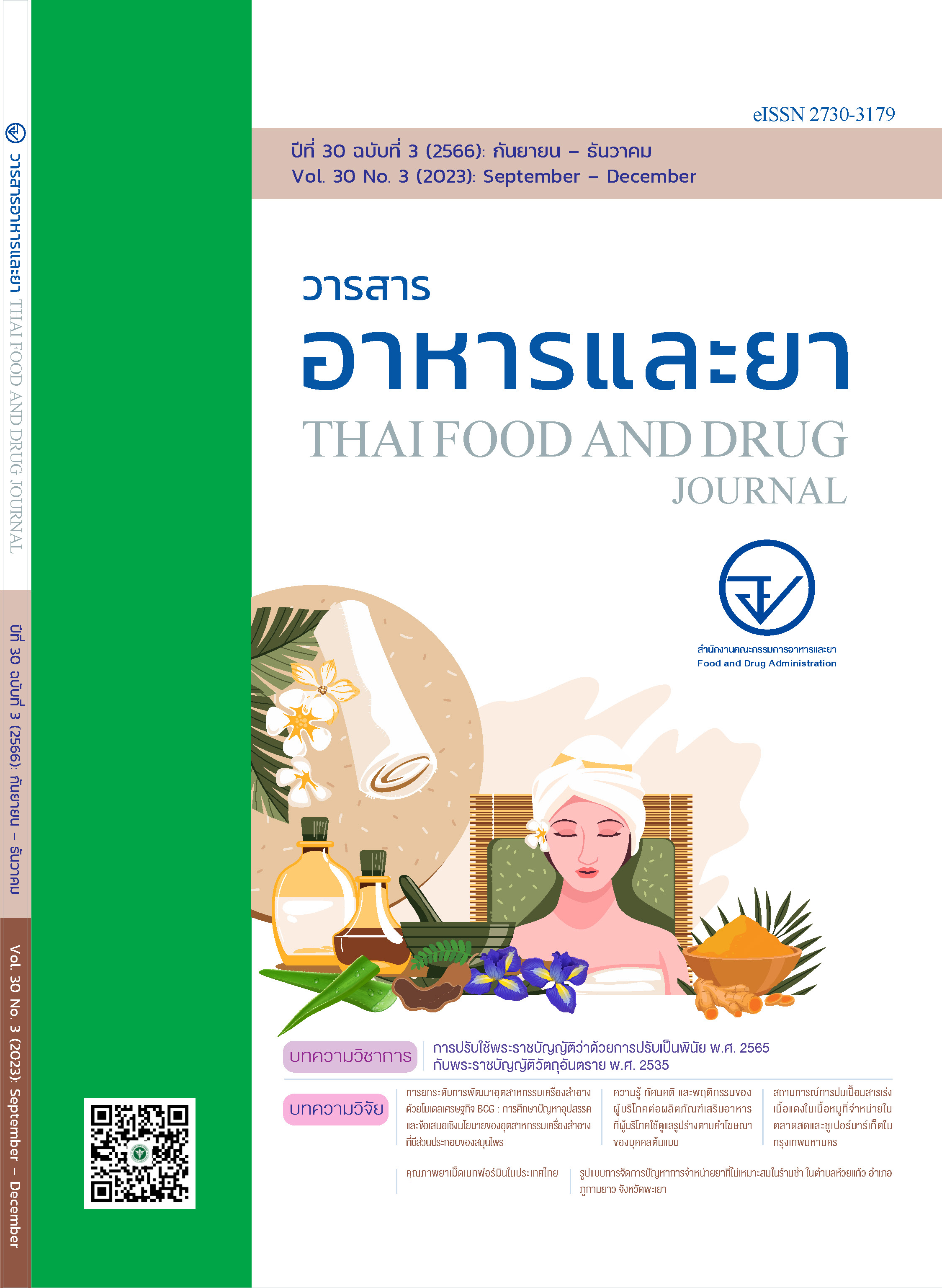รูปแบบการจัดการปัญหาการจำหน่ายยาที่ไม่เหมาะสมในร้านชำ ในตำบลห้วยแก้ว อำเภอ ภูกามยาว จังหวัดพะเยา
Main Article Content
บทคัดย่อ
ความสำคัญ: กฎหมายของประเทศไทยว่าด้วยยาตามพระราชบัญญัติยา พ.ศ. 2510 และฉบับแก้ไขเพิ่มเติม กำหนดให้ยาควบคุมพิเศษ ยาอันตราย ยาบรรจุเสร็จที่มิใช่ยาอันตรายหรือยาควบคุมพิเศษ จำหน่ายได้ในสถานที่ที่ได้รับอนุญาต และอนุญาตให้ยาสามัญประจำบ้านสามารถจำหน่ายได้ทั่วไป แต่พบว่ามีการกระจายยาที่ไม่เหมาะสมในร้านชำยังคงเป็นปัญหาสำคัญในหลายจังหวัดอันจะก่อให้เกิดผลกระทบต่อสุขภาพของผู้บริโภคระยะยาว ซึ่งพะเยาเป็นจังหวัดหนึ่งที่พบเหตุการณ์ที่ไม่ปลอดภัยจากการใช้ยาที่ไม่เหมาะสม เช่น การแพ้ยาจากการใช้ยาชุดและยาที่ไม่ได้ขึ้นทะเบียนตำรับ หรือแพ้ยาจากการซื้อยาปฏิชีวนะจากร้านชำมารักษาโรคด้วยตนเอง ส่วนในเชิงพื้นที่เช่นอำเภอภูกามยาวพบการจำหน่ายยาไม่เหมาะสมในร้านชำจำนวนมากขณะที่มีการส่งเสริมการใช้ยาปลอดภัยในชุมชนอย่างต่อเนื่อง
วัตถุประสงค์: เพื่อศึกษาสภาพปัญหาปัจจุบันในการจำหน่ายยาที่ไม่เหมาะสมในร้านชำ เพื่อพัฒนารูปแบบและศึกษาผลของรูปแบบการจัดการปัญหาการจำหน่ายยาที่ไม่เหมาะสมในร้านชำ
วิธีการวิจัย: เป็นการวิจัยเชิงปฏิบัติการในช่วงเดือนพฤศจิกายน 2562 – มกราคม 2563 ด้วยรูปแบบ PAOR (Plan, Action, Observation, and Reflection) โดยการศึกษาสภาพปัญหาและสำรวจการจำหน่ายยาใน
ร้านชำในพื้นที่ตำบลห้วยแก้ว อำเภอภูกามยาว จังหวัดพะเยา ก่อนและหลังพัฒนารูปแบบการจัดการปัญหา โดยคัดเลือกกลุ่มตัวอย่างแบบเจาะจง จากร้านชำทั้งหมดในพื้นที่ จำนวน 28 แห่ง พัฒนารูปแบบการจัดการปัญหาการจำหน่ายยาที่ไม่เหมาะสมในร้านชำด้วยกระบวนการมีส่วนร่วมของชุมชน โดยคัดเลือกกลุ่มตัวอย่างแบบเจาะจงที่เป็นผู้นำชุมชน บุคลากรภาครัฐที่เกี่ยวข้อง อาสาสมัครสาธารณสุขประจำหมู่บ้าน ประชาชน และตัวแทนเจ้าของร้านชำ จำนวน 40 คน เก็บข้อมูลโดยใช้แบบสอบถามและการประชุมกลุ่ม จากนั้นวิเคราะห์ข้อมูลเชิงปริมาณด้วยสถิติเชิงพรรณนาและเชิงอนุมาน และวิเคราะห์ข้อมูลเชิงคุณภาพโดยวิเคราะห์เชิงเนื้อหา
ผลการศึกษา: ผลสำรวจกลุ่มตัวอย่างร้านชำจำนวน 28 ตัวอย่าง พบว่าส่วนใหญ่เปิดให้บริการมาแล้ว 1- 5 ปี ร้อยละ 32.14 มีการศึกษาระดับประถมศึกษา ร้อยละ 46.43 เคยผ่านการอบรมหรือคำแนะนำจากบุคลากรสาธารณสุข ร้อยละ 64.28 เมื่อศึกษาถึงการจำหน่ายยาในร้านชำก่อนพัฒนารูปแบบการจัดการปัญหาการจำหน่ายยาที่ไม่เหมาะสมในร้านชำพบว่า มีการจำหน่ายยาไม่เหมาะสม ร้อยละ 89.28 (25 ร้าน) ซึ่งแรงจูงใจ 3 อันดับแรกมาจากความต้องการของคนในชุมชน เชื่อว่ายามีความปลอดภัย และต้องการผลกำไร ร้อยละ 88.00, 60.00 และ 52.00 ตามลำดับ โดยยาดังกล่าวมาจากร้านขายยาแผนปัจจุบันมากที่สุด ร้อยละ 96.00 และเป็นยาบรรจุเสร็จที่ไม่ใช่ยาสามัญประจำบ้านแผนปัจจุบันมากที่สุด ร้อยละ 96.00 ต่อมาเมื่อสร้างรูปแบบการจัดการปัญหาการจัดการปัญหาการจำหน่ายยาที่ไม่เหมาะสมในร้านชำด้วยกระบวนการมีส่วนร่วมของชุมชน โดยรับรู้สภาพปัญหาและกำหนดปัญหาร่วม จากนั้นกำหนดกิจกรรมประชาสัมพันธ์เผยแพร่ความรู้โดยจัดอบรมให้กับทีมแกนนำ อสม. 1 ครั้ง ๆ ละ 2 ชั่วโมง ให้ความรู้แก่ผู้บริโภคในพื้นที่ชุมชนทางสื่อต่าง ๆ ในรูปแบบป้าย
ไวนิล ดีวีดีสปอตวิทยุ และสื่อยาที่ห้ามขายในร้านชำ และมีการติดตามเฝ้าระวังอย่างสม่ำเสมอ ซึ่งผลการใช้รูปแบบการจัดการปัญหาการจำหน่ายยาที่ไม่เหมาะสมในร้านชำพบว่า มีการจำหน่ายยาที่ไม่เหมาะสมลดลงจาก ร้อยละ 98.28 เป็น 82.14 โดยมียาบรรจุเสร็จลดลงเล็กน้อยจากร้อยละ 85.71 เป็น 82.14 แต่ยาอันตรายและยาที่ไม่ได้ขึ้นทะเบียนตำรับลดลง ร้อยละ 14.28 และ 3.57 จาก 39.28 และ 17.86 ตามลำดับ ส่วนความรู้ ทัศนคติ และการมีส่วนร่วมของชุมชนพบว่าเพิ่มขึ้นอย่างมีนัยสำคัญทางสถิติที่ p-value <0.001
สรุป: รูปแบบการจัดการปัญหาการจำหน่ายยาที่ไม่เหมาะสมในร้านชำด้วยกระบวนการมีส่วนร่วมของชุมชน โดยกระตุ้นให้ชุมชนรับรู้สภาพปัญหา ร่วมกันวิเคราะห์สาเหตุและปัจจัยของปัญหาเพื่อกำหนดและเลือกมาตรการที่เหมาะสมในการแก้ไข ให้ชุมชนมีส่วนร่วมในการจัดกิจกรรม และติดตามประเมินผลอย่างต่อเนื่อง สามารถลดปัญหาการจำหน่ายยาที่ไม่เหมาะสมในร้านชำ ได้แก่ ยาอันตราย และยาที่ไม่ได้ขึ้นทะเบียนตำรับลดลง ส่วนความรู้ ทัศนคติ และการมีส่วนร่วมของกลุ่มตัวอย่างเพิ่มสูงขึ้นอย่างมีนัยสำคัญทางสถิติ
Article Details

อนุญาตภายใต้เงื่อนไข Creative Commons Attribution 4.0 International License.
เอกสารอ้างอิง
พระราชบัญญัติยา พ.ศ.2510. ราชกิจจานุเบกษา เล่มที่ 84, ตอนที่ 101 ฉบับพิเศษ (ลงวันที่ 20 ตุลาคม 2510).
วรรณา ศรีวิริยานุภาพ. ประเภทยาและข้อกำหนดของกฎหมายยาและวิชาชีพเภสัชกรรมที่เกี่ยวข้อง [อินเทอร์เน็ต]. กรุงเทพฯ: สภาเภสัชกรรม ; 2564. [เข้าถึงเมื่อ 23 มิ.ย. 2566]. เข้าถึงได้จาก: https://ccpe.pharmacycouncil.org/showfile.php?file=978
อัปสร บุญยัง, รุ่งทิวา หมื่นปา. ความชุกของการจำหน่ายยาที่ไม่เหมาะสมของร้านชำในจังหวัดพิษณุโลกและปัจจัยที่มีผล. วารสารเภสัชกรรมไทย 2562;11(1):105-18.
พยอม เพชระบูรณิน, สุรศักดิ์ เสาแก้ว. ความชุกของไม่ปลอดภัยในร้านชำ กรณีศึกษาอำเภอหล่มเก่า เขาค้อ และน้ำหนาว จังหวัดเพชรบูรณ์. วารสารเภสัชกรรมไทย 2562;11(2):422-30.
ศิริพร จิตรประสิทธิศิริ. ความชุกของการจำหน่ายยาอย่างผิดกฎหมายในร้านชำอำเภอสนามชัยเขต จังหวัดฉะเชิงเทรา. วารสารเภสัชกรรมไทย 2562;11(2):387-96.
สิริลักษณ์ รื่นรวย, สุรศักดิ์ เสาแก้ว. สถานการณ์ยาและผลิตภัณฑ์เสริมอาหารในเขตสุขภาพที่ 3. วารสารเภสัชกรรมไทย 2560,9(1):225-35.
สำนักงานสาธารณสุขจังหวัดพะเยา. รายงานผลการดำเนินงานคุ้มครองผู้บริโภคและเภสัชสาธารณสุข จังหวัดพะเยา ประจำปี 2560. พะเยา: สำนักงานสาธารณสุขจังหวัดพะเยา; 2561
สำนักงานสาธารณสุขจังหวัดพะเยา. รายงานผลการดำเนินงานคุ้มครองผู้บริโภคและเภสัชสาธารณสุข จังหวัดพะเยา ประจำปี 2561. พะเยา: สำนักงานสาธารณสุขจังหวัดพะเยา; 2562
สำนักงานสาธารณสุขจังหวัดพะเยา. รายงานผลการดำเนินงานคุ้มครองผู้บริโภคและเภสัชสาธารณสุข จังหวัดพะเยา ประจำปี 2562. พะเยา: สำนักงานสาธารณสุขจังหวัดพะเยา; 2563
Kemmis S, McTaggart R. The action research planner. 3rd ed. Victoria (Australia): Deakin University Press; 1988.
ธิดาพร อาจทวีกุล. การพัฒนาระบบการเฝ้าระวังการจำหน่ายยาอันตรายในร้านชำในเขตพื้นที่ตำบล
สะแกโพรง อำเภอเมือง จังหวัดบุรีรัมย์ [วิทยานิพนธ์ปริญญามหาบัณฑิต]. มหาสารคาม: มหาวิทยาลัยมหาสารคาม; 2559.
Bloom BS, Hastings JT, Madaus GF, Baldwin TS. Handbook on formation and summative evaluation of student learning. New York: McGraw-Hill Book Company; 1971.
Best JW, Kahn VJ. Research in education. 10th ed. United States of America: Pearson Education Inc; 2006.
อัจฉรีย์ สีหา, วรรณภา ศักดิ์ศิริ. การพัฒนารูปแบบการเฝ้าระวังความปลอดภัยด้านยาในร้านชำเขตอำเภอกมลาไส จังหวัดกาฬสินธุ์. วารสารวิจัยและพัฒนาระบบสุขภาพ 2565;15(1):304-17.
พงษ์ศักดิ์ นาต๊ะ, พักตร์วิภา สุวรรณพรหม, รัตนาภรณ์ อาวิพันธ์. การบูรณาการบทบาทของเภสัชกรด้านการคุ้มครองผู้บริโภคในระบบสุขภาพชุมชน. วารสารเภสัชกรรมไทย 2562;11(1):61-76.
สุธิดา บุญยศ, รุ่งทิวา หมื่นปา. สถานการณ์การกระจายและการใช้ยาสามัญประจำบ้านในชุมชน ณ อำเภอแห่งหนึ่งในภาคตะวันออกเฉียงเหนือ. วารสารเภสัชกรรมไทย 2564;13(3):578-89.
กัญญารัตน์ คุณหงส์, จีระศักดิ์ เจริญพันธ์, นิรุวรรณ เทรินโบล์. การพัฒนารูปแบบเสริมสร้างพลังอำนาจชุมชนในการคุ้มครองผู้บริโภคด้านเครื่องสำอาง ในพื้นที่ตำบลเสม็ด อำเภอเมือง จังหวัดบุรีรัมย์. วารสารมหาวิทยาลัยทักษิณ 2558;18(1):57-65.


